| |
BUSHSHRIKES Malaconotidae |
- 50 species in sub-Saharan Africa
- DR personal total: 31 species (62%), 17 photo'd
|
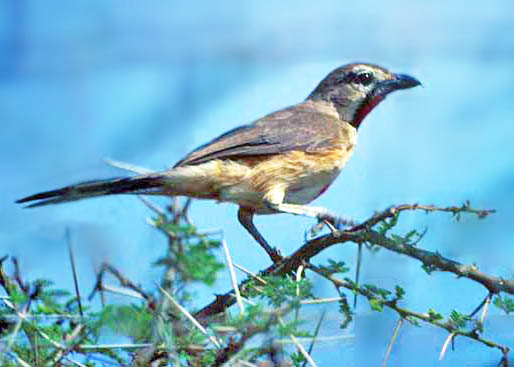 The Bushshrikes are an interesting group of colorful and often secretive species, bearing shrike-like bills, and almost restricted to sub-Saharan Africa. I was impressed with the first one I saw: Rosy-patched Bushshrike (left) of east Africa. It is a dry-country species from Ethiopia to Kenya and Tanzania. It is found in terrestrial pairs, running rapidly between the thorn-scrub bushes. Males (like this one) call and display from bush-tops. Although males have rosy throats, the bird is named for its rosy rump patch, best seen in flight. The Bushshrikes are an interesting group of colorful and often secretive species, bearing shrike-like bills, and almost restricted to sub-Saharan Africa. I was impressed with the first one I saw: Rosy-patched Bushshrike (left) of east Africa. It is a dry-country species from Ethiopia to Kenya and Tanzania. It is found in terrestrial pairs, running rapidly between the thorn-scrub bushes. Males (like this one) call and display from bush-tops. Although males have rosy throats, the bird is named for its rosy rump patch, best seen in flight.
The Malaconotidae includes boubous, gonoleks, puffbacks, tchagras, and Brubru. While boubous and puffbacks are patterned in various shades of black, gray, and white, the gonoleks are truly spectacular. A good example is Yellow-crowned Gonolek (below) of west Africa. It is difficult to spot these denizens of thickets in mostly arid country, often along river-courses, but the effort is worth it. The spectacular gonoleks and skulking, vocal bushshrikes are among my favorite birds in Africa. |
 |
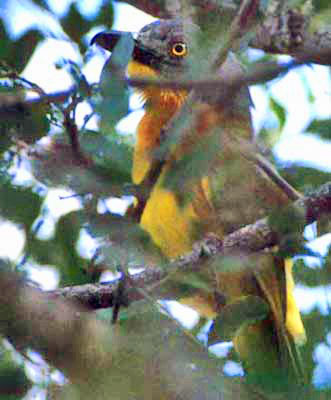 The family Malaconotidae is named for the bushshrikes in genus Malaconotus. These six species are the largest birds in the family. These these have loud and characteristic vocalizations, but all can be difficult to see. The songs consist of slowly repeated low-pitched, drawn-out, mournful whistles and harsh, raucous tearing sounds accompanied by loud bill-snapping (Harris & Franklin 2000). Four of this genus are rare and range-restricted montane species [Lagden's M. lagdeni, Green-breasted M. gladiator, Monteiro's M. monteiri, and Uluguru M. alius]. Fiery-breasted Bushshrike M. cruentus is a bird of lowland forests of west Africa. The widespread member of genus Malaconotus is Gray-headed Bushshrike (right) which inhabits thickets and brush in open savanna from west Africa to east Africa and southwards, but avoiding the Congo Basin and the deserts of southwest Africa. So far, even my best effort at a photo is screened by branches and leaves, but perhaps you can get a feeling of the big hooked bill, yellow eyed, and colorful orange-yellow underparts. The family Malaconotidae is named for the bushshrikes in genus Malaconotus. These six species are the largest birds in the family. These these have loud and characteristic vocalizations, but all can be difficult to see. The songs consist of slowly repeated low-pitched, drawn-out, mournful whistles and harsh, raucous tearing sounds accompanied by loud bill-snapping (Harris & Franklin 2000). Four of this genus are rare and range-restricted montane species [Lagden's M. lagdeni, Green-breasted M. gladiator, Monteiro's M. monteiri, and Uluguru M. alius]. Fiery-breasted Bushshrike M. cruentus is a bird of lowland forests of west Africa. The widespread member of genus Malaconotus is Gray-headed Bushshrike (right) which inhabits thickets and brush in open savanna from west Africa to east Africa and southwards, but avoiding the Congo Basin and the deserts of southwest Africa. So far, even my best effort at a photo is screened by branches and leaves, but perhaps you can get a feeling of the big hooked bill, yellow eyed, and colorful orange-yellow underparts.
Bush-shrikes are closely related to Helmet-Shrikes (Prionopidae), Vangas (Vangidae), and the Batises & Wattle-eyes (Platysteiridae). Indeed, most of the older literature lumps this group with one or more of these families. It was once thought they were also closely related to true Shrikes (Laniidae), but more recent biochemical research (e.g., Barker et al. 2004) shows that while they are both in the huge Corvoid assemblage, they are not really that closely related (a bit more on taxonomy below). The actual relationships between all these groups has recently received some resolution (Fuchs et al. 2004). |
 |
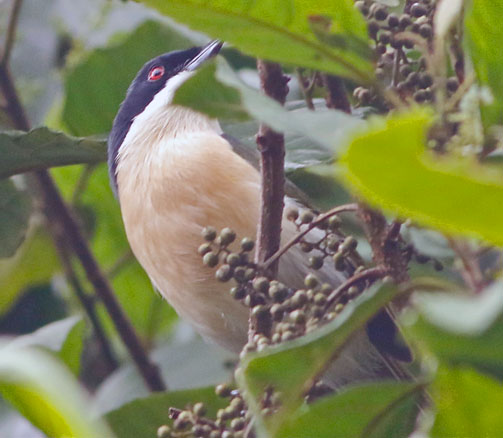 Genus Telophorus are the "small bushshrikes." The genus was first described from the South African species that goes by the Afrikaner name of Bokmakierie (above). It is more often heard than seen in the thorn veld. This one perched briefly at the top of dense thorn tree. Genus Telophorus are the "small bushshrikes." The genus was first described from the South African species that goes by the Afrikaner name of Bokmakierie (above). It is more often heard than seen in the thorn veld. This one perched briefly at the top of dense thorn tree.
Most of the 9 species in Telophorus are birds of montane forests, including the endangered Mount Kupe Bushshrike T. kupeensis. Some of them, such as Black-fronted Bushshrike (left), are elusive birds of the forest canopy, where they "creep and hop in a crouching position, peering around in search of prey." Black-fronted shows extensive polymorphism, sometimes in parallel with color morphs among the larger Malaconotus bushshrikes (Harris & Franklin 2000). All male Black-fronted Bushshrikes have black forecrowns and masks, but the color of the underparts can be orange, yellow, red, black or buff, depending on the color morph involved. This male, in the Usambara Mountains of Tanzania, is a buff morph.
Other small bushshrikes are skulkers in dense undergrowth, including Four-colored (Gorgeous) Bushshrike T. quadricolor. Doherty's Bushshrike (below left) is similar to Four-colored, but is endemic to the montane and submontane forests from Rwanda and southwest Uganda to western Kenya (below left). |
|
 Genus Laniarius has 22 species — and is the most diverse in the family, see Fuchs et al. (2004) — comprised of 14 boubous, 4 bushshrikes, and 4 gonoleks. Luhder's Bushshrike (above middle) is a bushshrike example; it is a secretive bird of thick scrub in the greater Congo Basin, such as abandoned clearings and open secondary forest, but avoids the primary forests in the center of the Congo Basin. Genus Laniarius has 22 species — and is the most diverse in the family, see Fuchs et al. (2004) — comprised of 14 boubous, 4 bushshrikes, and 4 gonoleks. Luhder's Bushshrike (above middle) is a bushshrike example; it is a secretive bird of thick scrub in the greater Congo Basin, such as abandoned clearings and open secondary forest, but avoids the primary forests in the center of the Congo Basin.
Some of the boubous (pronounced "boo-boo" so its a fun word to say) are pied black-and-white but many are undergrowth skulkers best located by loud fluty calls, males and females duetting to each other. Less so is Tropical Boubou (above right), which has a wide range from west to east (but not southern) Africa, where it is a bird of open woods, savannas, and gardens. Its bell-like duet song is commonly heard and is the source of the popular name "bellbird" [but is entirely unrelated to bellbirds in very different families from Australia and the Neotropics]. This population, on the edge of Ngorongoro Crater, Tanzania, has pale pink flanks and belly, but other populations of Tropical Boubou are all-white below. In fact there are 7 boubous that are black above, and pale below (white, pinkish, or yellow) and 7 boubous that are all-black. The black ones tend to be skulkers, clambering around in thickets and reminding me of black male antshrikes of several species in the Neotropics. One of those is Slate-colored Boubou of east Africa (right).
The four gonoleks are all incredibly fantastic, colorful and athletic despite their secretive ways. Gonoleks live in pairs that synchronized calls in duet. The duets have whistles and rattles; each pair has multiple versions of its duet; and each pair's repertoire is different than neighboring pairs. In courtship flight, calls include a sound similar to that made by winding in a fishing reel (Harris & Franklin 2000, Fry 2009). |
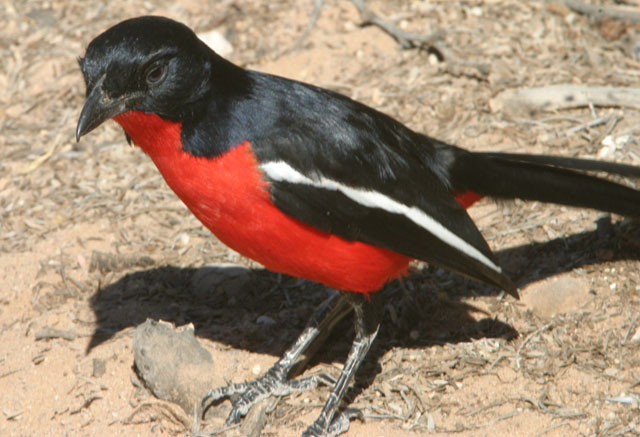
|
All four gonoleks are similar: both sexes are black above with bright crimson underparts. The species vary in crown color and the presence/absence of white wingstripe. The species replace each other geographically. The west African Yellow-crowned Gonolek is shown near top of page. The remaining three are:
- Crimson-breasted Gonolek: southern Africa centered on the Kalahari Basin and westwards (left);
- Black-headed Gonolek: north of the Congo Basin from Chad to east Africa (below far left).
- Papyrus Gonolek: a papyrus specialist between the upper Nile and Lake Victoria (middle & right below, 2 shots). At bottom right is a duetting pair, in papyrus, with a youngster peaking in.
|
|
Amazingly, the Crimson-breasted Gonolek (top left in gallery above) that I photographed at Mata Mata Camp in the Kgalagadi-Gemsbok NP, South Africa, had gotten used to people. It almost walked across my foot as it came to a water drip! The water-drip was an outdoor spigot in the camp, and I was washing and drying our laundry after 2 weeks on the road. It is so startlingly to encounter this drop-dead gorgeous bird at the edge of the vast expanse of Kalahari desert. All my prior experiences with gonoleks were occasional glimpses of bright color in dense thicks or papyrus swamps. And then what a difference digital photography has made! The Yellow-crowned and Crimson-breasted photos were digital, and far surpass what could be done with slide film that is then digitized (the photos of the bottom row of the above gallery).
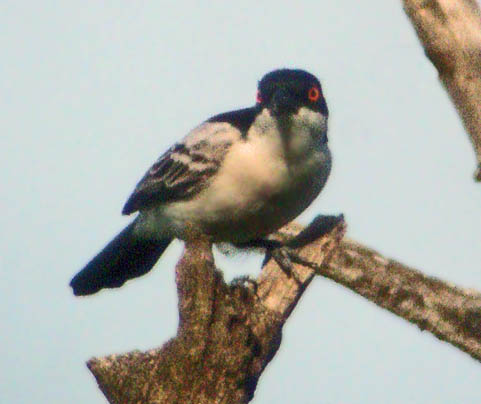 There are six species of Dryoscopus puffbacks. These more or less replace each other geographically, and where there is range overlap, it is generally between a montane forest species and a savanna or thorn-brush species in the lowlands below. This is a digiscoped shot of a Northern Puffback (right), a long way away in a savanna woodland in Ghana. There are six species of Dryoscopus puffbacks. These more or less replace each other geographically, and where there is range overlap, it is generally between a montane forest species and a savanna or thorn-brush species in the lowlands below. This is a digiscoped shot of a Northern Puffback (right), a long way away in a savanna woodland in Ghana.
All the species are patterned in some mix of black, white, and gray. Although there is a common central African species called Red-eyed Puffback Dryoscopus senegalensis, males of 4 of the 6 species have red eyes.
Puffbacks are not hard to see — most species forage in open the canopies of bushes or short trees, often with mixed species flocks — but they are named from the loose feathers on the male's rump and lower back. A male puffs out the white rump feathers "to form a remarkable white ball, then bows, droops vibrating wings, and spreads tail. He makes short 'butterfly' flights with the puff expanded, and may drop vertically through the air with raised wings. Courting birds audibly click their wings" (Zimmerman et al 1996). |
|
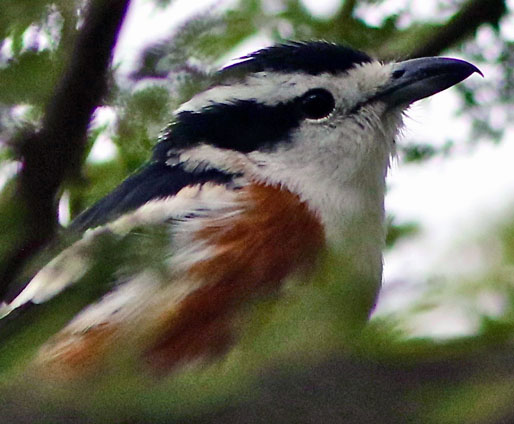 A common and widespread species is Brubru (left and two photos above). It is placed in its own genus (Nilaus). It is a bird of open broadleaf and Acacia woodlands, as well as thornscrub, feeding on invertebrates. The photos here were taken in very different parts of Africa. The two shots above, including a Brubru trying to deal with a large worm captured in the canopy, were taken in nw. South Africa, at about the southwestern most of its widespread sub-Saharan range. This is a long distance from the Brubru shown in close-up (left) in thornscrub of northeast Tanzania. Based on range, the Tanzanian bird (left) is subspecies Nilaus afer minor, while the one from South Africa (above) is Nilaus afer brubru [a very odd scientific name indeed, including the full Latin species name and the English name! I've never seen this combo before....]. A common and widespread species is Brubru (left and two photos above). It is placed in its own genus (Nilaus). It is a bird of open broadleaf and Acacia woodlands, as well as thornscrub, feeding on invertebrates. The photos here were taken in very different parts of Africa. The two shots above, including a Brubru trying to deal with a large worm captured in the canopy, were taken in nw. South Africa, at about the southwestern most of its widespread sub-Saharan range. This is a long distance from the Brubru shown in close-up (left) in thornscrub of northeast Tanzania. Based on range, the Tanzanian bird (left) is subspecies Nilaus afer minor, while the one from South Africa (above) is Nilaus afer brubru [a very odd scientific name indeed, including the full Latin species name and the English name! I've never seen this combo before....].
So these two populations look similar: well-patterned black-and-white head and upperparts, white underparts, chestnut flanks. Yet, between them geographically, are populations in miombo (Brachystegia) woodland in south-central Africa that lack the prominent supercilium stripe that reaches the nape, and instead are black-capped.
All populations give variations on the standard Brubru song: a far-carrying, high-pitched trill, varying regionally from fast buzz with individual notes barely discernible, to slower, telephone-like trilling ring (Fry 2009).
Brubru has a tangled taxonomic history, and was at one time variously placed with the shrikes [Laniidae], bush-shrikes [Malaconotidae], helmet-shrikes [Prionopidae], or Old World Flycatchers [Muscicapidae]. "Its batis-like plumage, helmet-shrike-like tarsal scutellation and nest, and true shrike-like bill, juvenal plumage and behavior have fueled the debate" (Harris & Franklin 2000). Fortunately, that debate is now over as Fuchs et al. (2004) show it is firmly within the Bushshrike family. |
 |
 The final set is the 5 species of tchagras in genus Tchagra. It can be a challenge to distinguish between the two widespread tchagras unless good views are obtained; they have head patterns reminding me of large versions of the Worm-eating Warbler Helmitheros vermivorus in North America. The thicket-dweller, across most of sub-Saharan Africa (except the south), is Brown-crowned Tchagra (above). [The longer-billed Southern Tchagra T. tchagra fills the niche in southernmost Africa]. Black-crowned Tchagra (below) has an even wider range, that includes parts of north Africa and southern Arabia, overlaps with Brown-crowned in many places. Black-crowned's habitat is more open, such as shrubby thicks in grasslands or savanna. [Three-streaked Tchagra T. jamesi is a grayer bird living in deserts of the Horn of Africa.] Territorial pairs of both Brown-crowned and Black-crowned Tchagras gives duets; male Brown-crowns also sing in display-flights (Fry 2009). The final set is the 5 species of tchagras in genus Tchagra. It can be a challenge to distinguish between the two widespread tchagras unless good views are obtained; they have head patterns reminding me of large versions of the Worm-eating Warbler Helmitheros vermivorus in North America. The thicket-dweller, across most of sub-Saharan Africa (except the south), is Brown-crowned Tchagra (above). [The longer-billed Southern Tchagra T. tchagra fills the niche in southernmost Africa]. Black-crowned Tchagra (below) has an even wider range, that includes parts of north Africa and southern Arabia, overlaps with Brown-crowned in many places. Black-crowned's habitat is more open, such as shrubby thicks in grasslands or savanna. [Three-streaked Tchagra T. jamesi is a grayer bird living in deserts of the Horn of Africa.] Territorial pairs of both Brown-crowned and Black-crowned Tchagras gives duets; male Brown-crowns also sing in display-flights (Fry 2009).
The final tchagra is now called Marsh Tchagra (male, right). Its old name was "Blackcap Bush-Shrike" and it was once in a monotypic genus ("Bocagia"). It hides in rank vegetation and reedbeds of swamps in west and central Africa. Harris & Franklin (2000) retained it in a monotypic genus as it differs from Tchagra in a variety of ways: it is sexually dimorphic, and differs in eye color, tail color, communication behavior, and nest decoration. However, molecular work shows it is close to Tchagra (Fuchs et al. 2004), and it is now moved to that genus. |
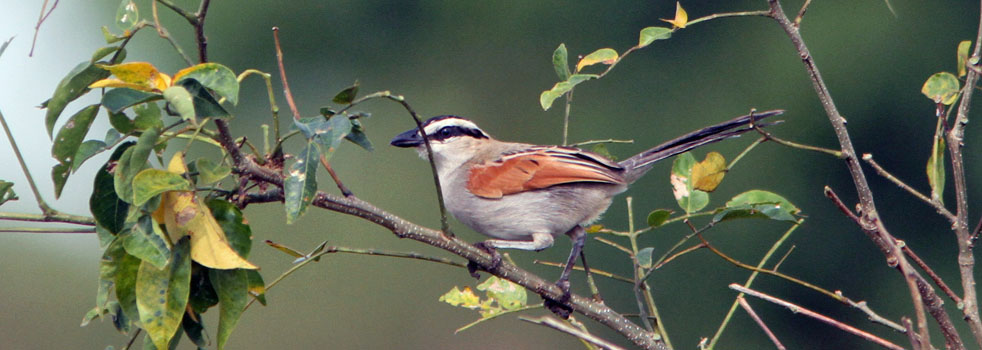 |
| |
Photos: The Rosy-patched Bushshrike Rhodophoneus cruentus was in Tsavo West NP, Kenya, on 25 Nov 1981 [this male with a black-bordered throat patch is of race cathemagmena, which occurs south of the Equator in Kenya; I also have a photo of a male of the race hilgerti from Samburu NP, north of the equator, whose rosy throat is more extensive and not bordered with anything at all. The two subspecies do not intergrade (emergent species?)]. The Yellow-crowned Gonolek Laniarius barbarus was at the Mole River crossing at Mognori, near Mole NP, Ghana, on 13 Dec 2013. The Gray-headed Bushshrike Malaconotus blanchoti was in Kruger NP, South Africa, on 27 July 1996. The Bokmakierie Telophorus zeylonus was Grosse Spitzkoppe NR, Namibia, on 17 July 2005. The Black-fronted Bushshrike Telophorus nigrifrons was at Mkuzi, Usambara Mts., Tanzania, on 4 June 2018. The Doherty's Bush-Shrike Telophorus dohertyi was at Ruhiza, in Bwindi-Impenetrable Forest NP, Uganda, on 19 July 2002; the Luhder's Bush-Shrike Laniarius luehderi was also Ruhiza that same date, just a couple miles along the same dirt road. The Tropical Boubou Laniarius aethiopicus was at the Sopa Lodge, on the rim of Ngorongoro Crater, Tanzania, on 11 June 2018. The Slate-colored Boubou Laniarius funebris was in Samburu NR, Kenya, on 13 Nov 1981. The Crimson-breasted Gonolek Laniarius aethiopicus was at Mata Mata camp in Kgalagadi–Gemsbok NP, South Africa, on 12 July 2005. The Black-headed Gonolek Laniarius erythrogaster was at Queen Eliz. II NP, Uganda, on 25 July 2002. The family of Papyrus Gonolek Laniarius mufumbiri was in papyrus lining the Kazinga Channel, Queen Eliz. II NP, Uganda, on 24 July 2002. The digiscoped male Northern Puffback Dryoscopus gambensis was in Shai Hills NP, Ghana, on 28 Nov 2013. The Tropical Boubou Laniarius aethiopicus was at the Sopa Lodge, on the rim of Ngorongoro Crater, Tanzania, on 11 June 2018. The two shots of Brubru Nilaus afer brubru were taken in Augrabies Falls NP, South Africa, on 9 July 2005; the close-up of Nilaus afer minor was at Engikaret, Arusha, Tanzania, on 7 June 2018. The Brown-crowned Tchagra Tchagra australis was in Tarangire NP, Tanzania, on 9 June 2018. The Marsh Tchagra Tchagra minutus was in a marsh at Brenu Beach, Ghana, on 9 Dec 2013. The Black-crowned Tchagra Tchagra senegalus was on the Winneba Plains, Ghana, on 1 Dec 2013.
All photos © Don Roberson; all rights reserved.
Family book: Rating 
Harris, T., and K. Franklin. 2000. Shrikes & Bush-Shrikes. Princeton Univ. Press, Princeton, N.J.
This is a very attractive offering in the Princeton bird families series. Tony Harris wrote the text; Kim Franklin did the plates. It has the familiar layout of plates altogether in the front, with range maps and i.d. summary, and detailed species accounts in the back. It looks well researched and has a good bibliography. I very much enjoyed the full-page spreads, with black-and-white sketch, on each genus in the groups covered, that highlights the introduction. There is a lot of discussion of taxonomy but, unfortunately, the authors chose to follow the Sibley & Monroe (1990) approach of only two families: shrikes [Laniidae] and bush-shrikes [Malaconotidae]. All of the batises, wattle-eyes, helmet shrikes, and such things as flycatcher-shrikes, wood-shrikes, and philentomas, are thrown into the latter family. New research does not support this approach. As it turns out, the true shrikes are not the closest relatives to the rest of this set (e.g., Barker et al. 2004), so even the premise of this book proves false. Further, vangas (not included in this book) are closely related to the rest of the group. Indeed, it appears that the flycatcher-shrikes are vangas, and that helmet-shrikes are very closely related to vangas (Cibois et al. 1999, 2001). The text also suffers from the author's use of the "Species Recognition Concept" as his definition for species; fortunately, in practice, in works rather like the tried-and-true "Biological Species Concept." Yet both in its language and in its reliance on DNA hybridization evidence (Sibley & Ahlquist 1990), this book has the unfortunate status of being out-of-date taxonomically much more quickly than would be anticipated.
That having been said, the species accounts, maps, and paintings for the species that are included all are very good. This is a well-written book with attractive paintings. It is great to have a world overview of the species that are included, even if they do not hang together as a group. One major annoyance: citations in the text are small-print superscript numbers. A list of these numbers is in the back of the book, but the list does not give the full citation. Rather, citation number 732 is "Emlen 1979." One then has to go check the bibliography to locate the full citation to Emlen's note in Scopus on fiscal shrikes. This is an entirely unnecessary double effort for the reader, and should have been fixed by the publisher (just number the bibliography if you use this tactic; see Dickinson 2003 for an example of the proper way to do this). Despite all these criticisms, it IS a very attractive publication and quite useful in many ways. So I give it 4 (of 5) stars despite its limitations. The basic, underlying information about each taxa, and the attractive plates, make up for a lot.
Another excellent introduction to this family, with supreb photos, is in Fry (2009) in the Handbook of the Birds of the World series.
Literature cited:
Barker, F.K., A. Cibois, P. Schikler, J. Feinstein, and J. Cracraft. 2004. Phylogeny and diversification of the largest avian radiation. Proc. Nat. Acad. Sci. 101: 11040–11045.
Beresford, P., F.K. Barker, P.G. Ryan, and T.M. Crowe. 2005. African endemics span the tree of songbirds (Passeri): molecular systematics of several evolutionary 'enigmas'. Proc. R. Soc. B 272: 849–858.
Cibois, A., E. Pasquet, and T.S. Schulenberg. 1999. Molecular systematics of the Malagasy babblers (Timaliidae) and Warblers (Sylviidae), based on cytochrome b and 16S rRNA sequences. Molec. Phylog. Evol. 3: 581–595.
Cibois, A., B. Slikas, T.S. Schulenberg, and E. Pasquet. 2001. An endemic radiation of Malagasy songbirds is revealed by mitochondrial DNA sequence data. Evolution 55: 1198–1206.
Dowsett, R. J., and F. Dowsett-Lemaire. 1993. "Comments on the taxonomy of some Afrotropical bird species," pp. 232-389 in A Contribution to the Distribution and Taxonomy of Afrotropical and Malagasy Birds (R. J. Dowsett & F. Dowsett-Lemaire, eds.). Tauraco Res. Rpt. 5. Tauraco Press, Liége.
Fry, C.H. 2009. Family Malaconotidae (Bush-shrikes), pp. 50–122 in Handbook of the Birds of the World (del Hoyo, J., A. Elliott & D.A. Christie, eds). Vol. 14. Lynx Edicions, Barcelona, Spain.
Fuchs, J., R.C.K. Bowie, J. Fjeldsa, and E. Pasquet. 2004. Phylogenetic relationships of the African bush-shrikes and helmet-shrikes (Passeriformes: Malaconotidae). Molec. Phylog. Evol. 33: 428–439.
Keith, S., E. K. Urban, and C. H. Fry, eds. 1992. The Birds of Africa. Vol. 4. Academic Press, London. Schulenberg, T.S. 2003. "The Radiations of Passerine Birds of Madagascar," pp. 1130–1134 in S.M. Goodman & J.P. Benstead (eds.) The Natural History of Madagascar.
Sibley, C. G., and J. E. Ahlquist. 1990. Phylogeny and Classification of Birds: A Study in Molecular Evolution. Yale Univ. Press, New Haven, CT.
Sibley, C. G., and B. L. Monroe, Jr. 1990. Distribution and Taxonomy of Birds of the World. Yale Univ. Press, New Haven, CT.
Traylor, M. A. 1986. "Platysteiridea," "Muscicapidae," et al. in Check-list of Birds of the World (E. Mayr & G. W. Cotrell, eds). Vol. 11. Harvard Univ. Press, Cambridge, MA.
Zimmerman, D. A., D. A. Turner, and D. J. Pearson. 1996. Birds of Kenya and northern Tanzania. Christopher Helm, London.
|
|
|





 The Bushshrikes are an interesting group of colorful and often secretive species, bearing shrike-like bills, and almost restricted to sub-Saharan Africa. I was impressed with the first one I saw: Rosy-patched Bushshrike (left) of east Africa. It is a dry-country species from Ethiopia to Kenya and Tanzania. It is found in terrestrial pairs, running rapidly between the thorn-scrub bushes. Males (like this one) call and display from bush-tops. Although males have rosy throats, the bird is named for its rosy rump patch, best seen in flight.
The Bushshrikes are an interesting group of colorful and often secretive species, bearing shrike-like bills, and almost restricted to sub-Saharan Africa. I was impressed with the first one I saw: Rosy-patched Bushshrike (left) of east Africa. It is a dry-country species from Ethiopia to Kenya and Tanzania. It is found in terrestrial pairs, running rapidly between the thorn-scrub bushes. Males (like this one) call and display from bush-tops. Although males have rosy throats, the bird is named for its rosy rump patch, best seen in flight. The family Malaconotidae is named for the bushshrikes in genus Malaconotus. These six species are the largest birds in the family. These these have loud and characteristic vocalizations, but all can be difficult to see. The songs consist of slowly repeated low-pitched, drawn-out, mournful whistles and harsh, raucous tearing sounds accompanied by loud bill-snapping (Harris & Franklin 2000). Four of this genus are rare and range-restricted montane species [Lagden's M. lagdeni, Green-breasted M. gladiator, Monteiro's M. monteiri, and Uluguru M. alius]. Fiery-breasted Bushshrike M. cruentus is a bird of lowland forests of west Africa. The widespread member of genus Malaconotus is Gray-headed Bushshrike (right) which inhabits thickets and brush in open savanna from west Africa to east Africa and southwards, but avoiding the Congo Basin and the deserts of southwest Africa. So far, even my best effort at a photo is screened by branches and leaves, but perhaps you can get a feeling of the big hooked bill, yellow eyed, and colorful orange-yellow underparts.
The family Malaconotidae is named for the bushshrikes in genus Malaconotus. These six species are the largest birds in the family. These these have loud and characteristic vocalizations, but all can be difficult to see. The songs consist of slowly repeated low-pitched, drawn-out, mournful whistles and harsh, raucous tearing sounds accompanied by loud bill-snapping (Harris & Franklin 2000). Four of this genus are rare and range-restricted montane species [Lagden's M. lagdeni, Green-breasted M. gladiator, Monteiro's M. monteiri, and Uluguru M. alius]. Fiery-breasted Bushshrike M. cruentus is a bird of lowland forests of west Africa. The widespread member of genus Malaconotus is Gray-headed Bushshrike (right) which inhabits thickets and brush in open savanna from west Africa to east Africa and southwards, but avoiding the Congo Basin and the deserts of southwest Africa. So far, even my best effort at a photo is screened by branches and leaves, but perhaps you can get a feeling of the big hooked bill, yellow eyed, and colorful orange-yellow underparts.  Genus Telophorus are the "small bushshrikes." The genus was first described from the South African species that goes by the Afrikaner name of Bokmakierie (above). It is more often heard than seen in the thorn veld. This one perched briefly at the top of dense thorn tree.
Genus Telophorus are the "small bushshrikes." The genus was first described from the South African species that goes by the Afrikaner name of Bokmakierie (above). It is more often heard than seen in the thorn veld. This one perched briefly at the top of dense thorn tree. 
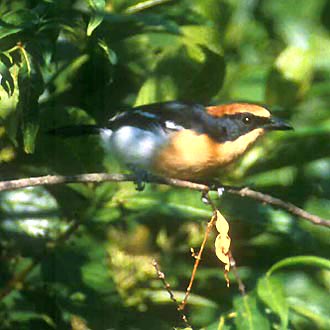
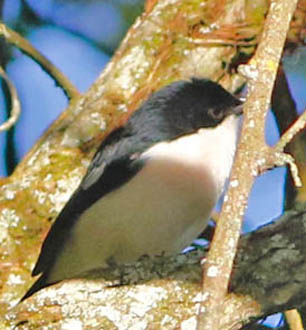
 Genus Laniarius has 22 species — and is the most diverse in the family, see Fuchs et al. (2004) — comprised of 14 boubous, 4 bushshrikes, and 4 gonoleks. Luhder's Bushshrike (above middle) is a bushshrike example; it is a secretive bird of thick scrub in the greater Congo Basin, such as abandoned clearings and open secondary forest, but avoids the primary forests in the center of the Congo Basin.
Genus Laniarius has 22 species — and is the most diverse in the family, see Fuchs et al. (2004) — comprised of 14 boubous, 4 bushshrikes, and 4 gonoleks. Luhder's Bushshrike (above middle) is a bushshrike example; it is a secretive bird of thick scrub in the greater Congo Basin, such as abandoned clearings and open secondary forest, but avoids the primary forests in the center of the Congo Basin. 


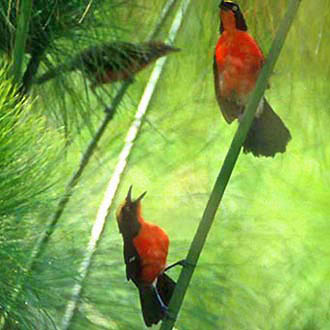
 There are six species of Dryoscopus puffbacks. These more or less replace each other geographically, and where there is range overlap, it is generally between a montane forest species and a savanna or thorn-brush species in the lowlands below. This is a digiscoped shot of a Northern Puffback (right), a long way away in a savanna woodland in Ghana.
There are six species of Dryoscopus puffbacks. These more or less replace each other geographically, and where there is range overlap, it is generally between a montane forest species and a savanna or thorn-brush species in the lowlands below. This is a digiscoped shot of a Northern Puffback (right), a long way away in a savanna woodland in Ghana. 
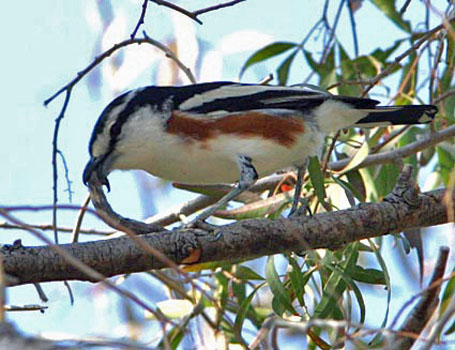
 A common and widespread species is Brubru (left and two photos above). It is placed in its own genus (Nilaus). It is a bird of open broadleaf and Acacia woodlands, as well as thornscrub, feeding on invertebrates. The photos here were taken in very different parts of Africa. The two shots above, including a Brubru trying to deal with a large worm captured in the canopy, were taken in nw. South Africa, at about the southwestern most of its widespread sub-Saharan range. This is a long distance from the Brubru shown in close-up (left) in thornscrub of northeast Tanzania. Based on range, the Tanzanian bird (left) is subspecies Nilaus afer minor, while the one from South Africa (above) is Nilaus afer brubru [a very odd scientific name indeed, including the full Latin species name and the English name! I've never seen this combo before....].
A common and widespread species is Brubru (left and two photos above). It is placed in its own genus (Nilaus). It is a bird of open broadleaf and Acacia woodlands, as well as thornscrub, feeding on invertebrates. The photos here were taken in very different parts of Africa. The two shots above, including a Brubru trying to deal with a large worm captured in the canopy, were taken in nw. South Africa, at about the southwestern most of its widespread sub-Saharan range. This is a long distance from the Brubru shown in close-up (left) in thornscrub of northeast Tanzania. Based on range, the Tanzanian bird (left) is subspecies Nilaus afer minor, while the one from South Africa (above) is Nilaus afer brubru [a very odd scientific name indeed, including the full Latin species name and the English name! I've never seen this combo before....]. The final set is the 5 species of tchagras in genus Tchagra. It can be a challenge to distinguish between the two widespread tchagras unless good views are obtained; they have head patterns reminding me of large versions of the Worm-eating Warbler Helmitheros vermivorus in North America. The thicket-dweller, across most of sub-Saharan Africa (except the south), is Brown-crowned Tchagra (above). [The longer-billed Southern Tchagra T. tchagra fills the niche in southernmost Africa]. Black-crowned Tchagra (below) has an even wider range, that includes parts of north Africa and southern Arabia, overlaps with Brown-crowned in many places. Black-crowned's habitat is more open, such as shrubby thicks in grasslands or savanna. [Three-streaked Tchagra T. jamesi is a grayer bird living in deserts of the Horn of Africa.] Territorial pairs of both Brown-crowned and Black-crowned Tchagras gives duets; male Brown-crowns also sing in display-flights (Fry 2009).
The final set is the 5 species of tchagras in genus Tchagra. It can be a challenge to distinguish between the two widespread tchagras unless good views are obtained; they have head patterns reminding me of large versions of the Worm-eating Warbler Helmitheros vermivorus in North America. The thicket-dweller, across most of sub-Saharan Africa (except the south), is Brown-crowned Tchagra (above). [The longer-billed Southern Tchagra T. tchagra fills the niche in southernmost Africa]. Black-crowned Tchagra (below) has an even wider range, that includes parts of north Africa and southern Arabia, overlaps with Brown-crowned in many places. Black-crowned's habitat is more open, such as shrubby thicks in grasslands or savanna. [Three-streaked Tchagra T. jamesi is a grayer bird living in deserts of the Horn of Africa.] Territorial pairs of both Brown-crowned and Black-crowned Tchagras gives duets; male Brown-crowns also sing in display-flights (Fry 2009). 